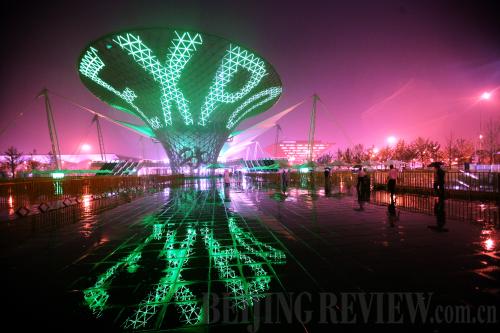|
 |
|
The Expo Axis (WANG XIANG) |
October marks the closing month for the Shanghai World Expo. Chen Ran, a Chinese journalist with the magazine Beijing Review, and Lise Capko, a Beninese researcher at La Sorbonne in Paris
Hit-and-Miss at the Expo
by Lise Capko
After several visits to the Shanghai World Expo, I began to wonder about the official slogan "Better City, Better Life." While the pavilions focus on the cultural, technological, and developmental aspects of their countries, the Expo theme is often absent.
There are a few notable exceptions. The Italian pavilion does an excellent job in showcasing the essence of what it means to be Italian - a heady mix classicism and modernity, all executed with inimitable style, while managing to include the Expo theme. Upon entering the glass cube which forms a corner of the starkly modern concrete design, the visitor is faced with a columned two-story Greco-Roman facade.
On its second floor, the Italian pavilion explores the Expo theme by focusing on several Italian cities and their historical developments, presented in a dreamy montage of photos, animated projections, and multimedia displays.
The Vietnamese pavilion is entirely constructed of ingeniously linked bamboo poles. The Sri Lankan pavilion is attractively-proportioned and influenced by Mahayana Buddhist temples, but the concept of "Better City, Better Life" is not evident in either.
Overall, I feel that the biggest missed opportunity, in terms of exploring the Expo theme, is in the site itself. The lack of relaxing green space, and limited transportation options all fail to realize the promise implied in the slogan "Better City, Better Life." The impression of the Expo being an advertisement for the participating countries is reinforced by the ads plastered around Shanghai, stating "不出国门看遍世博," meaning "do not go abroad, go to the Expo."
But, the Expo does a pretty good job in dealing with the crowds and long queues. Efficient English-speaking volunteers are posted all over, and there are convenience stores and a decent number of restaurants, both inside and outside the pavilions. To help the crowds deal with the heat, mist machines are installed at many of the longer lines.
The best solution would have been a VIP pass for direct entry.
Arriving at Expo after 5pm allows you the purchase of an evening pass for 90 yuan, and the site is relatively less crowded in the evening, not to mention cooler. Another tip – check out the less popular, more idiosyncratic pavilions for short-to-nonexistent wait times – the Asian Joint Pavilion and the African Pavilion can be walked into with no wait whatsoever.
One of my personal favorites is the Moroccan Pavilion. After a 5-minute queue, the overheated visitor is presented with a serene pillared courtyard with a pool in the center, open to the three floors above, with exhibitions of mannequins wearing traditional clothing off to the side. Weapons, bronze, pottery, and other artwork are displayed in the surrounding alcoves. The second floor emulates a souk or bazaar with various kiosks highlighting traditional products and artisanal crafts of the country, such as metalworking, textiles, pottery, shoes, confectionaries and spices. Traditional music adds to the atmosphere, while the 3rd floor contrasts with a simple panoramic screen showing aspects of modern life including IT and renewable energy.
While the pavilions varied in their overall experiences, I felt it was interesting to see the manner in which these countries present themselves to the world. I learned a lot, despite the fact that information was scarce at times.
The people of Shanghai are proud that their city has been chosen as host, and rightfully so. Will there be a long-term cultural and economic impact? Only time will tell. One thing is certain – the lead up to the Expo found Shanghai furiously building, improving, rejuvenating, and reconfiguring the fabric of the city itself,and these changes will forever be part of Shanghai's history.
|